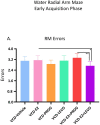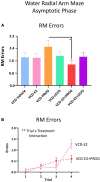Clinically Used Hormone Formulations Differentially Impact Memory, Anxiety-Like, and Depressive-Like Behaviors in a Rat Model of Transitional Menopause
- PMID: 34366807
- PMCID: PMC8335488
- DOI: 10.3389/fnbeh.2021.696838
Clinically Used Hormone Formulations Differentially Impact Memory, Anxiety-Like, and Depressive-Like Behaviors in a Rat Model of Transitional Menopause
Abstract
A variety of U.S. Food and Drug Administration-approved hormone therapy options are currently used to successfully alleviate unwanted symptoms associated with the changing endogenous hormonal milieu that occurs in midlife with menopause. Depending on the primary indication for treatment, different hormone therapy formulations are utilized, including estrogen-only, progestogen-only, or combined estrogen plus progestogen options. There is little known about how these formulations, or their unique pharmacodynamics, impact neurobiological processes. Seemingly disparate pre-clinical and clinical findings regarding the cognitive effects of hormone therapies, such as the negative effects associated with conjugated equine estrogens and medroxyprogesterone acetate vs. naturally circulating 17β-estradiol (E2) and progesterone, signal a critical need to further investigate the neuro-cognitive impact of hormone therapy formulations. Here, utilizing a rat model of transitional menopause, we administered either E2, progesterone, levonorgestrel, or combinations of E2 with progesterone or with levonorgestrel daily to follicle-depleted, middle-aged rats. A battery of assessments, including spatial memory, anxiety-like behaviors, and depressive-like behaviors, as well as endocrine status and ovarian follicle complement, were evaluated. Results indicate divergent outcomes for memory, anxiety, and depression, as well as unique physiological profiles, that were dependent upon the hormone regimen administered. Overall, the combination hormone treatments had the most consistently favorable profile for the domains evaluated in rats that had undergone experimentally induced transitional menopause and remained ovary-intact. The collective results underscore the importance of investigating variations in hormone therapy formulation as well as the menopause background upon which these formulations are delivered.
Keywords: VCD; anxiety; depression; estrogen; levonorgestrel; memory; menopause; progesterone.
Copyright © 2021 Koebele, Hiroi, Plumley, Melikian, Prakapenka, Patel, Carson, Kirby, Mennenga, Mayer, Dyer and Bimonte-Nelson.
Conflict of interest statement
The authors declare that the research was conducted in the absence of any commercial or financial relationships that could be construed as a potential conflict of interest.
Figures














Similar articles
-
Characterizing the effects of tonic 17β-estradiol administration on spatial learning and memory in the follicle-deplete middle-aged female rat.Horm Behav. 2020 Nov;126:104854. doi: 10.1016/j.yhbeh.2020.104854. Epub 2020 Sep 25. Horm Behav. 2020. PMID: 32949557 Free PMC article.
-
Impact of menopausal hormone formulations on pituitary-ovarian regulatory feedback.Am J Physiol Regul Integr Comp Physiol. 2019 Dec 1;317(6):R912-R920. doi: 10.1152/ajpregu.00234.2019. Epub 2019 Oct 30. Am J Physiol Regul Integr Comp Physiol. 2019. PMID: 31663769 Free PMC article. Clinical Trial.
-
Benefits of Hormone Therapy Estrogens Depend on Estrogen Type: 17β-Estradiol and Conjugated Equine Estrogens Have Differential Effects on Cognitive, Anxiety-Like, and Depressive-Like Behaviors and Increase Tryptophan Hydroxylase-2 mRNA Levels in Dorsal Raphe Nucleus Subregions.Front Neurosci. 2016 Dec 8;10:517. doi: 10.3389/fnins.2016.00517. eCollection 2016. Front Neurosci. 2016. PMID: 28008302 Free PMC article.
-
Uterine bleeding with hormone therapies in menopausal women: a systematic review.Climacteric. 2020 Dec;23(6):550-558. doi: 10.1080/13697137.2020.1806816. Epub 2020 Sep 7. Climacteric. 2020. PMID: 32893694
-
The prevention of breast cancer through reduced ovarian steroid exposure.Acta Oncol. 1992;31(2):167-74. doi: 10.3109/02841869209088898. Acta Oncol. 1992. PMID: 1622631 Review.
Cited by
-
Altered brain rhythms and behaviour in the accelerated ovarian failure mouse model of human menopause.Brain Commun. 2022 Jun 22;4(4):fcac166. doi: 10.1093/braincomms/fcac166. eCollection 2022. Brain Commun. 2022. PMID: 35794872 Free PMC article.
-
Evaluating the Cognitive Impacts of Drospirenone, a Spironolactone-Derived Progestin, Independently and in Combination With Ethinyl Estradiol in Ovariectomized Adult Rats.Front Neurosci. 2022 May 25;16:885321. doi: 10.3389/fnins.2022.885321. eCollection 2022. Front Neurosci. 2022. PMID: 35692432 Free PMC article.
-
Evaluations of memory, anxiety, and the growth factor IGF-1R after post-surgical menopause treatment with a highly selective progestin.Behav Brain Res. 2023 Jun 25;448:114442. doi: 10.1016/j.bbr.2023.114442. Epub 2023 Apr 20. Behav Brain Res. 2023. PMID: 37085118 Free PMC article.
-
How preclinical models of menopause can inform clinical care: A focus on midlife and reciprocal communication between clinical and preclinical science.Curr Opin Endocr Metab Res. 2023 Feb;28:100434. doi: 10.1016/j.coemr.2023.100434. Epub 2023 Jan 13. Curr Opin Endocr Metab Res. 2023. PMID: 39484630 Free PMC article.
-
Corticosterone disrupts spatial working memory during retention testing when highly taxed, which positively correlates with depressive-like behavior in middle-aged, ovariectomized female rats.Horm Behav. 2024 Aug;164:105600. doi: 10.1016/j.yhbeh.2024.105600. Epub 2024 Jul 14. Horm Behav. 2024. PMID: 39003890 Free PMC article.
References
-
- Acosta J. I., Mayer L., Talboom J. S., Tsang C. W. S., Smith C. J., Enders C. K., et al. (2009). Transitional versus surgical menopause in a rodent model: etiology of ovarian hormone loss impacts memory and the acetylcholine system. Endocrinology 150 4248–4259. 10.1210/en.2008-1802 - DOI - PMC - PubMed
Grants and funding
LinkOut - more resources
Full Text Sources

